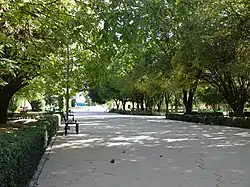Zarqan
Persian: زرقان | |
|---|---|
City | |
 Azadi Park in Zarqan | |
 Zarqan | |
| Coordinates: 29°46′06″N 52°43′07″E / 29.76833°N 52.71861°E[1] | |
| Country | |
| Province | Fars |
| County | Zarqan |
| District | Central |
| Population (2016)[2] | |
| • Total | 32,261 |
| Time zone | UTC+3:30 (IRST) |
Zarqan (Persian: زرقان, also Romanized as Zarqān; also known as Zarghanak and Zargān)[3] is a city in the Central District of Zarqan County, Fars province, Iran, serving as both capital of the district and of the county.[4] The city is served by Zarqan Airport.
At the 2006 National Census, its population was 19,861 in 5,127 households, when it was in the former Zarqan District of Shiraz County.[5] The following census in 2011 counted 28,958 people in 8,112 households.[6] The latest census in 2016 showed a population of 32,261 people in 9,591 households.[2]
In July 2018, the district was separated from the county in the establishment of Zarqan County, which was divided into two districts of two rural districts each, with Zarqan as its capital.[4]
Etymology
Zarqan comes from "Zarghoon", which in Pahlavi means the place is lush.
Zarqan in books
It is said that Zarqan had good mules for hiring and transporting.[7] Therefore, this city was important for business and transportation during 1791.[8] Historically, Zaqan counted as the battle field among Afghan and Afshari dynasty.[9]
See also
References
- ↑ OpenStreetMap contributors (1 October 2023). "Zarqan, Zarqan County" (Map). OpenStreetMap. Retrieved 1 October 2023.
- 1 2 "Census of the Islamic Republic of Iran, 1395 (2016)". AMAR (in Persian). The Statistical Center of Iran. p. 07. Archived from the original (Excel) on 6 April 2022. Retrieved 19 December 2022.
- ↑ Zarqan can be found at GEOnet Names Server, at this link, by opening the Advanced Search box, entering "-3089115" in the "Unique Feature Id" form, and clicking on "Search Database".
- 1 2 Jahangiri, Ishaq (10 July 2018). "Approval letter regarding country divisions of Zarqan District, Shiraz County, Fars province". Martyrdom of Imam Ali (AS) Research Center of the Islamic Council (in Persian). Ministry of Interior, Council of Ministers. Archived from the original on 21 April 2022. Retrieved 1 October 2023.
- ↑ "Census of the Islamic Republic of Iran, 1385 (2006)". AMAR (in Persian). The Statistical Center of Iran. p. 07. Archived from the original (Excel) on 20 September 2011. Retrieved 25 September 2022.
- ↑ "Census of the Islamic Republic of Iran, 1390 (2011)". Syracuse University (in Persian). The Statistical Center of Iran. p. 07. Archived from the original (Excel) on 16 January 2023. Retrieved 19 December 2022.
- ↑ Matthee, Rudolph P. (9 December 1999). The Politics of Trade in Safavid Iran: Silk for Silver, 1600-1730. Cambridge University Press. pp. 50–. ISBN 978-0-521-64131-9.
- ↑ Avery, Peter; Hambly, Gavin R. G.; Melville, Charles P., eds. (10 October 1991). The Cambridge History of Iran. Cambridge University Press. pp. 579–. ISBN 978-0-521-20095-0.
- ↑ Axworthy, Michael (2006). The Sword of Persia: Nader Shah, From Tribal Warrior to Conquering Tyrant. I.B. Tauris. p. 103. ISBN 978-1-85043-706-2.
